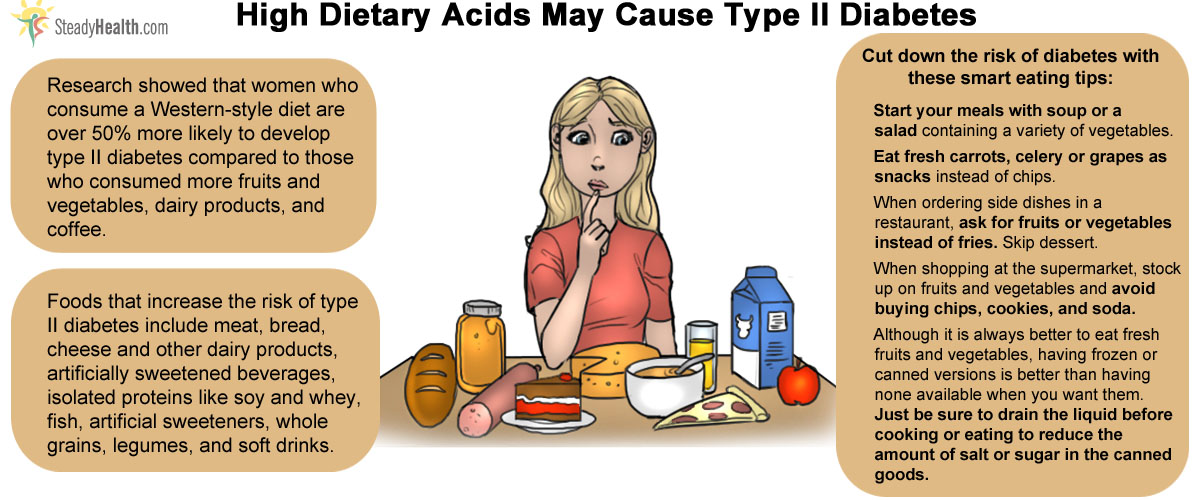There are so many different factors that can lead one to an increased risk for diabetes, including a diet high in carbohydrates. New findings, however, reveal that a high dietary acid load with frequent meat consumption, is also a significant risk factor.
You've probably already heard that eating lots of sugar can increase your risk of diabetes. Most people, in fact, know that a diet high in carbohydrates or sugar increases their risk for developing diabetes. Although diabetes is typically thought to be one condition, it is actually a group of diseases. This means the risk factors of getting diabetes depends on what type you're talking about. Diabetes mellitus or type II diabetes, for instance, is a chronic condition characterized by high blood sugar levels, which can lead to various health complications.
Factors that Increase Diabetes Risk
In 2011, it was estimated that about 8% of the US population has diabetes. This includes almost 26 million adults and children, but not counting another 79 million people who have a condition called prediabetes. Prediabetes is a condition where one has blood sugar levels that are higher than the normal range but not high enough to be diagnosed as diabetes.
Meals that are high in carbohydrates can make blood sugar levels rise. The pancreas releases a hormone, called insulin, which helps transport glucose (sugar) from your blood into the cells, which convert it to energy. People who have diabetes have been found to be resistant to the effects of insulin, resulting in glucose not being used up by the cells, and remaining in the blood. The pancreas produces more insulin, but not enough to reduce sugar levels in the blood, resulting in diabetes.
New Findings
In search for more knowledge about what factors increase the likelihood of developing diabetes, French researchers examined the diets of more than 66,000 women ages 46-60 over a period of 14 years. The investigators, led by Guy Fagherazzi, PhD, from Gustave Roussy Institute in Villejuif, France found that dietary acids may play a significant role in the development of diabetes. Foods that increase the dietary acid load include meat, fish, bread, cheese, and artificially sweetened beverages. These foods are characteristic of a "Western" dietary pattern, which is high in animal products and other acid-producing foods.
Read More: Diabetes type 2 - Causes and Prevention
The researchers also found that these associations persisted regardless of other known risk factors for diabetes. For instance, women who were of normal body weight but consumed a high acid diet were at a higher risk for diabetes than those who were overweight. However, there is no evidence of causality or direct relationship between this particular pattern of eating and diabetes, since the data also showed that study participants who ate high acid foods were also more likely to have other risk factors such as obesity, inactivity, and positive family history.
Yet, it is worthwhile to consider how modifying our diet can improve our chances of fighting against a growing problem.
Foods That Increase Dietary Acid Load
Foods that increase dietary acid load do not have anything to do with their acidic taste, which is characteristic of lemons or oranges. The acid-forming properties of food are related to the way they are broken down when they are digested. High-protein foods such as animal meat products tend to be high in amino acids that are metabolized to form sulfuric acid.

Acid-forming foods can put a heavy load on the kidneys, which are tasked with the job of neutralizing acids to maintain proper pH balance in the body. Normally, the body is able to neutralize acids from the metabolism of food, but chronic consumption of high acid diets can result in health problems. When the kidney regulatory function is not able to counteract the acidity, the body “borrows” from other Buffering sources, such as the bones, which release calcium and phosphorus, or the muscles, which release glutamine. These compensatory mechanisms may result in osteoporosis and muscle loss.
Modifying the Diet to Prevent Diabetes
Unlike animal products, most foods that come from plants (fruits and vegetables) do not contain high levels of amino acids that contain sulfur. They are therefore, generally alkaline-formingfoods, which help neutralize acid-forming foods.
The mechanisms linking a high acid diet and diabetes are not clear but research suggests that acid/base imbalances play a role in cardiometabolic abnormalities. Increased acidity in the body may lead to increased insulin resistance and metabolic syndrome, which increase the risk for diabetes. Without a change in diet, chronic metabolic acidosis can lead to complications. One study found that a high dietary acid load in diabetic individuals with renal complications can lead to end-stage renal disease. The authors believe that kidney failure can be prevented by shifting to an alkaline diet, which consists of eating more fruits and vegetables.
Read More: Dietary Treatment Of Type 2 Diabetes Mellitus - Effectiveness Of Nuts
The American Diabetes Association shares some tips for smart eating to cut down the risk for diabetes:
-
Start your meals with soup and salad containing a variety of vegetables. This helps fill you up before eating the main course, which may have a higher calorie and fat content.
-
Eat fresh carrots, celery or grapes for snacks instead of chips.
-
When ordering side dishes in a restaurat, ask for fruits or vegetables instead of fries. Order some soup or salad to fill up before eating a shared entree. Skip dessert.
-
When shopping at the supermarket, stock up on fruits and vegetables and avoid buying chips, cookies, and soda.
-
Although it is always better to eat fresh fruits and vegetables, having frozen or canned versions is better than having none available when you want them. Just be sure to drain the liquid before cooking or eating to reduce the amount of salt or sugar in the canned goods.
- Mindmap by steadyhealth.com
- Photo courtesy of Shizhao by Wikimedia Commons : simple.wikipedia.org/wiki/File:FoodMeat.jpg



Your thoughts on this